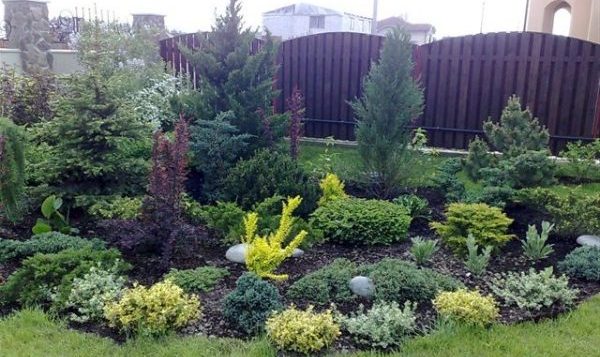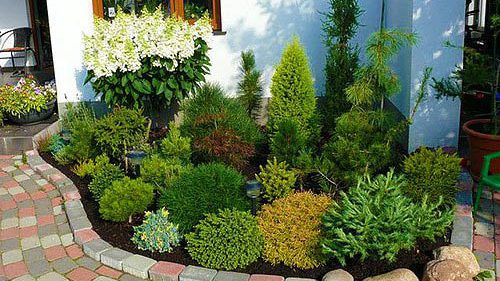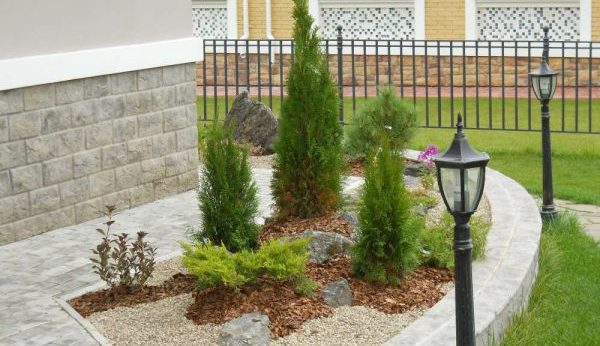We decorate a beautiful bed of conifers
Content
Scheme and plants
A flowerbed consisting of several types of coniferous crops is considered a complex landscape composition, therefore it is rather difficult to create it with your own hands in an arbitrary style without preliminary preparation and a plan. You need to start creating a flower bed with conifers by drawing up a diagram on which the location of each plant is applied in detail. A correctly drawn up flower bed diagram should take into account the following points:
- the territory on which the bed with conifers will be located should be in an open, sunny place;
- so that the coniferous composition does not merge, the plants should be contrasting in color, shape and size;
- priority in the flower bed should be given to compact and undersized varieties - against their background, single conifers look more advantageous;
- at the planning stage, you should decide on the finishing materials used for framing and decorating flower beds - conifers look more effective in a stone frame;
- in the plan, all conifers, stones, additional decorative elements should be displayed as accurately as possible, and the sequence of their planting is indicated by numbers.
Next, you should decide on the method of decorating a flower bed with coniferous plantations. There can be several composition options:
- Compact. The flowerbed occupies a small area on which conifers are planted with each other: mountain pine in the center or in the background, several thujas and junipers at the edges.
- Bunk. The coniferous composition consists of two layers of plants, kept in the same style and combined in size and style: ground cover juniper - the first tier, rocky juniper in combination with dwarf pine or spruce - the second tier.
- Horizontal. This coniferous composition is located on a gentle surface, where all the conifers are planted at the same level. Most often, several varieties of juniper, undersized conifers are used in the design.
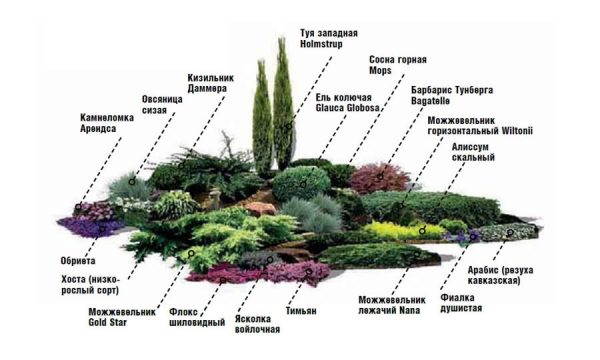
- Big. It is located mainly along fences, fences and contains several types of conifers located in 3-4 rows.
- A flower bed imitating a forest. This coniferous composition consists of several decorative trees (spruce, fir, mountain pine, juniper) and resembles a forest landscape.
- Rocky bed with conifers. This is an imitation of a mountain landscape with low-growing conifers and ground cover juniper on the rocks.
- Mixborder with conifers. A composition consisting of perennial flowers (irises, lilies, roses) and stones, where coniferous crops are located in the center and along the edges.
When creating a composition with conifers with your own hands, the question often arises: what other plants can be planted so that they are combined with coniferous plantings? The most popular coniferous species are: spruce, low-growing mountain pine, fir, thuja, junipers of various varieties. In addition, the coniferous composition can be supplemented with any flowering perennials.
Of the many plants, roses are most effectively combined with coniferous cultures, because it is the green color that creates a bright contrast and favorably sets off the roses. The coniferous composition, in which roses are present, is distinguished by special sophistication and sophistication. Roses in a mixborder can be planted of various varieties, while it is better to plant low-growing and ground cover roses along the edge, and in the center, against the background of tall trees (thujas, fir trees) - bush, standard roses. White lilies and blue irises are also combined well with greens, but still bright multi-colored roses in combination with conifers create a special accent on such a flower bed.
Video "All about coniferous compositions in the garden"
Demonstration video with expert recommendations on the design of coniferous compositions in the garden or on the territory of a private house.
Step-by-step instructions for creating
Arranging any flower bed with your own hands begins with preparing the soil. And in the case of conifers, the soil must be prepared especially carefully, since they are planted once for many years. First, you need to dig deep into the area, since the roots of most conifers are quite long. The soil for conifers should be loose, with good drainage properties, preferably sandy loam with neutral acidity.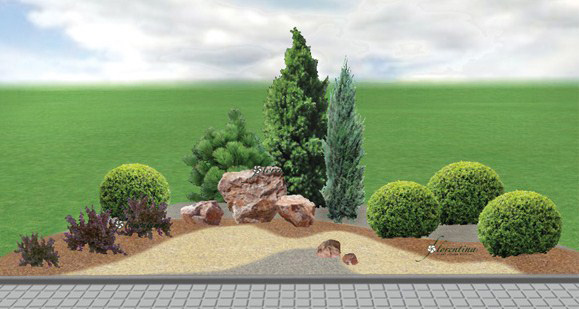
After digging from the soil, you need to remove all lumps, roots, weeds, apply mineral fertilizers suitable for a particular type of conifers that will be planted in a flower bed. Peat and sand should be added to clayey heavy soil, and a little sod land should be added to sandy soil. If the flower bed is small, you can buy soil for it at a flower shop - they sell ready-made soil mixtures for each individual type of coniferous trees and shrubs.
After the soil in the flowerbed is prepared, you can start decorating the composition of conifers. Here it is important to transfer the schematic plan of the flower bed as accurately as possible to a real piece of land.
This process is as follows:
- Delineate the boundaries of the flower bed according to the plan.
- Decorate the contours with pre-selected materials: stone, curb bricks, crushed stone.
- Next, use a peg to mark the places of planting of conifers. At the same time, it is necessary to correctly calculate the distance between the conifers so that in the future they do not shade and displace each other.
- Dig holes (holes) for plants, taking into account the length of the rhizomes: for conifers 60-70 cm, for low-growing shrubs - 40-50 cm.
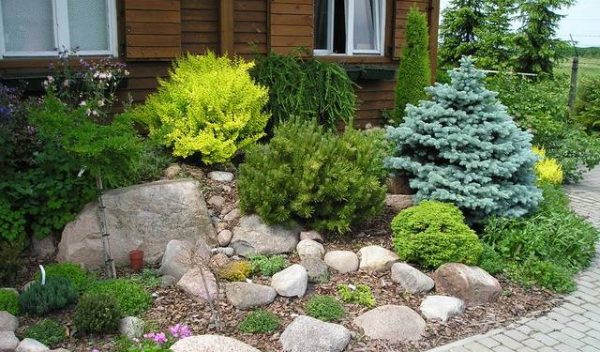
- Pour a layer of rubble and sand at the bottom of each hole to allow air and moisture to circulate in the soil.
- Then add a fertilizer mixture suitable for the type of coniferous plant in each well.
- Place the seedlings vertically in the hole.
- Pour half of the soil into the hole, then lightly tamp it.
- Next, fill in the remaining soil and compact the surface again.
- Now water the ephedra thoroughly.
- Cover wet soil with soil residues and smooth the surface well.
After the coniferous composition is planted, the soil should be mulched in the flower bed. When choosing a material, it is advisable to take into account not only the decorative properties of the material, but also its practical benefits for plants - organic mulch: fine crushed stone, granite chips, wood chips and sawdust, in addition to the mulching function, also improve the properties of the soil.
How to care
In general, conifers are unpretentious, but this is true only for rooted and adult conifers. Young seedlings after planting in a flower bed can begin to wither rapidly, and most often this is due to a change in soil - a temporary substrate containing special additives is placed in pots with coniferous seedlings in the store. And after planting, the plants find themselves in a completely different environment, and this is a real stress for them.If the seedlings of young conifers begin to die, it is necessary to add special fertilizing to the soil, or add earth brought from the forest.
In the future, caring for coniferous crops consists of a considerable list of activities, however, they need to be performed only as needed:
- Watering. In the first year of planting, young conifers are watered at intervals of 1 time per week. Most adult conifers do not need watering at all, with the exception of abnormal heat or prolonged drought.
- Sprinkling. This procedure is performed only in the absence of rain for a long time. However, if desired, irrigation of the crown can be carried out more often - from this, coniferous plantations will only become more attractive.
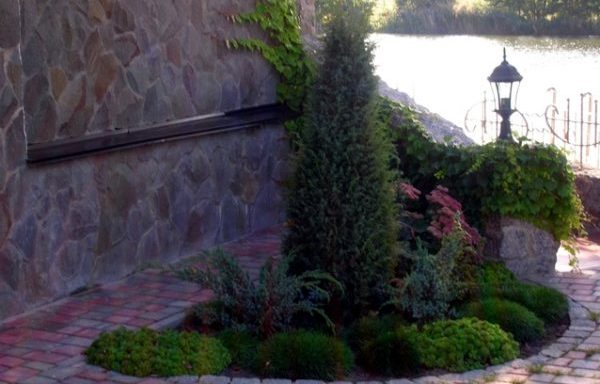
- Weeding. The flowerbed needs to remove weeds, as a rule, in the first years, when the coniferous composition has not grown enough. In the future, the plantings will create a shade, and the weeds will stop growing. If the flowerbed consists of undersized compact shrubs or dwarf varieties of conifers, weeding is carried out more often, since the weeds create a shadow over them and impede growth.
- Mulching. A shelter made of organic material can be made both in the near-trunk circles and over the entire surface in the flower bed. Mulch has many useful functions for plants: it prevents the growth of weeds, retains moisture, and reduces soil freezing. On a bed of conifers, it will be more than appropriate to look at mulch from the remnants of needles - needles, cones, coniferous bark, sawdust.
- Loosening. In the first 3 years, loosening of the soil between coniferous stands should be carried out regularly to a depth of 7-10 cm after each watering. Then the soil is simply mulched.
- Top dressing. Coniferous crops do not need frequent feeding. Mineral mixtures with humates, specially designed for conifers, are applied once in spring or early summer.
- Pruning. Planned pruning of coniferous crops is carried out at the end of August - September in order to give the composition a decorative form.
- Fight against drying out of needles. From extreme heat and lack of moisture, ephedra can turn yellow and crumble. In this case, therapeutic measures are needed with spraying the crown with special solutions: Gimisol, Immunocytovitis.
In winter, a coniferous flower bed needs special protection. The soil between the conifers is mulched with a dense layer of peat, compost, dry foliage, coniferous needles, and the conifers themselves are tied with a strong rope so that the crown is not damaged under the pressure of snow. Low-growing varieties can be completely covered - this will protect them not only from snow, but also from the sudden spring sun.
Video "A selection of options for flower beds"
Video selection of various options for flower beds for the garden and site.

